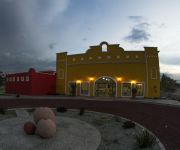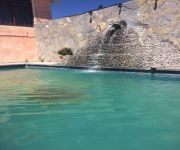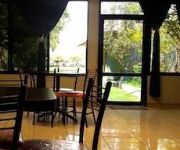Safety Score: 3,6 of 5.0 based on data from 9 authorites. Meaning please reconsider your need to travel to Mexico.
Travel warnings are updated daily. Source: Travel Warning Mexico. Last Update: 2024-08-13 08:21:03
Delve into Lagunilla
The district Lagunilla of in Estado de México is a district located in Mexico about 19 mi north-east of Mexico City, the country's capital town.
In need of a room? We compiled a list of available hotels close to the map centre further down the page.
Since you are here already, you might want to pay a visit to some of the following locations: Tezoyuca, Papalotla, Teotihuacan, Tecamac and Tepetlaoxtoc. To further explore this place, just scroll down and browse the available info.
Local weather forecast
Todays Local Weather Conditions & Forecast: 19°C / 66 °F
| Morning Temperature | 9°C / 47 °F |
| Evening Temperature | 17°C / 62 °F |
| Night Temperature | 11°C / 53 °F |
| Chance of rainfall | 0% |
| Air Humidity | 15% |
| Air Pressure | 1019 hPa |
| Wind Speed | Gentle Breeze with 8 km/h (5 mph) from South |
| Cloud Conditions | Clear sky, covering 1% of sky |
| General Conditions | Sky is clear |
Tuesday, 26th of November 2024
20°C (67 °F)
10°C (51 °F)
Sky is clear, moderate breeze, clear sky.
Wednesday, 27th of November 2024
20°C (69 °F)
15°C (58 °F)
Sky is clear, gentle breeze, clear sky.
Thursday, 28th of November 2024
22°C (72 °F)
16°C (60 °F)
Sky is clear, gentle breeze, clear sky.
Hotels and Places to Stay
Hotel Teotihuacan
Hotel Teoticamp
Villas Arqueologicas Teotihuacan
Hotel Boutique El Jaguar
Hotel Quetzalcalli
Telpochcalli Hotel & Temazcal
Posada Jade Teotihuacán
Videos from this area
These are videos related to the place based on their proximity to this place.
Castillo de feria de Santa Maria Magdalena, Tepexpan Acolman, 28 de julio 2013
Castillo de feria de Santa Maria Magdalena, Tepexpan Acolman, 28 de julio 2013.
Banda Juvenil de Marcha de la Escuela Normal de Ecatepec, en Acolman 2010
Banda Juvenil de Marcha de la Escuela Normal de Ecatepec, en el concurso del Municipio de Acolman 2010, primera parte Direccion de Marcha Mtro. Gabriel Hernandez Guzman, Asistente de ...
castillo de feria de Santa Maria Magdalena, Tepexpan Acolman 4 de agosto 2013 parte 2 de 2
castillo de feria de Santa Maria Magdalena, Tepexpan Acolman 4 de agosto 2013 parte 2 de 2.
Bandfest Acolman 2012 - Jaguares & Tecuanes
Participacion de la Banda Jaguares & Tecuanes de Tepalcingo Morelos en la edicion 2012 del Bandfest de Acolman Estado de Mexico.
TAMBORES DE TEXCOCO SONIDO LA CONGA EN CUANALAN ACOLMAN 2012 .AVI
que rolon festejando 2º aniv de producciones el pillo aunque n este completo pero ya casi terminaba (perdon x eso)
SONIDO LA CONGA COL, EMILIANO ZAPATA ACOLMAN 2012 cumbia loca
por primera vez se presenta sonido la conga en la col emiliano zapata se encuentra entre los pueblos Granjas Familiares Acolman y Santa Catarina Acolman.
Videos provided by Youtube are under the copyright of their owners.
Attractions and noteworthy things
Distances are based on the centre of the city/town and sightseeing location. This list contains brief abstracts about monuments, holiday activities, national parcs, museums, organisations and more from the area as well as interesting facts about the region itself. Where available, you'll find the corresponding homepage. Otherwise the related wikipedia article.
Teotihuacan
Teotihuacan, also written Teotihuacán, is an enormous archaeological site in the Basin of Mexico, 30 miles northeast of Mexico City, containing some of the largest Mesoamerican pyramids built in the pre-Columbian Americas. The name means "where man met the gods. " Apart from the pyramids, Teotihuacan is also known for its large residential complexes, the Avenue of the Dead, and numerous colorful, well-preserved murals.
Texcoco (altepetl)
Texcoco was a major Acolhua city-state in the central Mexican plateau region of Mesoamerica during the Late Postclassic period of pre-Columbian Mesoamerican chronology. It was situated on the eastern bank of Lake Texcoco in the Valley of Mexico, to the northeast of the Aztec capital, Tenochtitlan. The site of pre-Columbian Texcoco is now subsumed by the modern Mexican municipio of Texcoco and its major settlement, the city formally known as Texcoco de Mora.
Ecatepec de Morelos
Ecatepec, once officially San Cristóbal Ecatepec de Morelos, is a city in the State of Mexico and the seat of Ecatepec de Morelos Municipality; however, both the city and the municipality are often known simply as "Ecatepec". The name "Ecatepec" is derived from Nahuatl, and means "windy hill" or "hill devoted to Ehecatl". It was also an alternative name or invocation to Quetzalcoatl. "Morelos" is the last name of José María Morelos, a hero of the Mexican War of Independence.
Pyramid of the Moon
The Pyramid of the Moon is the second largest pyramid in Teotihuacan, Mexico after the Pyramid of the Sun. It is located in the western part of Teotihuacan and mimics the contours of the mountain Cerro Gordo, just north of the site. Some have called it Tenan, which in Nahuatl, means "mother or protective stone. " The Pyramid of the Moon covers a structure older than the Pyramid of the Sun which existed prior to 200 AD.
Chapingo, State of Mexico
Chapingo is a small town located on the outskirts of the city of Texcoco, Mexico State in central Mexico. It is located at {{#invoke:Coordinates|coord}}{{#coordinates:19|29|N|98|53|W||| | |name= }}, about 25 km west of Mexico City International Airport. Chapingo is most notable as the location of Chapingo Autonomous University (Universidad Autónoma Chapingo). The UACh, as it is known, is the country's most prestigious center for agricultural studies.
Temple of the Feathered Serpent, Teotihuacan
The Temple of the Feathered Serpent is the modern-day name for the third largest pyramid at Teotihuacan, a pre-Columbian site in central Mexico. This structure is notable partly due to the discovery in the 1980s of more than a hundred possibly-sacrificial victims found buried beneath the structure. The burials, like the structure, are dated to some time between 150 and 200 CE. The pyramid takes its name from representations of the Mesoamerican "feathered serpent" deity which covered its sides.
Pyramid of the Sun
The Pyramid of the Sun is the largest building in Teotihuacan and one of the largest in Mesoamerica. Found along the Avenue of the Dead, in between the Pyramid of the Moon and the Ciudadela, and in the shadow of the massive mountain Cerro Gordo, the pyramid is part of a large complex in the heart of the city.
San Salvador Atenco
San Salvador Atenco is the municipal seat of Atenco, in the Mexican state of Mexico. The name "Atenco" comes from a Nahuatl phrase meaning "place on the edge of water".
Tepexpan, State of Mexico
Tepexpan is the largest town in the Acolman municipality in the State of Mexico, Mexico. The population was 48,103 as of the 2005 Mexican census. One of the most interesting aspects of this town is the discovery of an early Mesoamerican skeleton commonly referred to as "Tepexpan man". Recent research tries to show that the skeleton was not that of a man but that of a woman. The woman was apparently trampled by a raging mastodon around 11,000 BCE.
Chiconcuac de Juárez
Chiconcuac de Juárez, typically referred to simply as Chiconcuac, is a town and municipio in the state of Mexico, approximately 10 kilometers north of Texcoco de Mora. The name Chiconcuac derives from the Aztec word Chicome Coatl, “Seven snakes”, which was a date on the Aztec calendar.
Metro Ecatepec
Ecatepec is a station on Line B of the Mexico City Metro system. It is in the Ecatepec de Morelos city in the State of Mexico adjacent to Mexico City. The station opened on November 30, 2000, under its original name, Metro Tecnológico. The station's icon was the emblem of the Tecnológico de Estudios Superiores de Ecatepec, whose facilities are located nearby.
Metro Olímpica
Olímpica is a station on Line B of the Mexico City Metro system. The station is located at Avenida Central and Avenida Valle de Santiago in the Colonia Jardines de Aragón neighborhood and Avenida Grecia in the Colonia La Olimpica II neighborhood in the State of Mexico adjacent to Mexico City. The logo of the station features the five interlaced Olympic rings of the Olympic Games logo. The station was opened on 30 November 2000.
Metro Plaza Aragón
Plaza Aragón is a surface station on Line B of the Mexico City Metro system. The station was opened on 30 November 2000. It is located in the median of Avenida Carlos Hank González in the Colonia Rinconada de Aragón neighborhood in the State of Mexico adjacent to Mexico City. The station logo depicts pots for sale at a tianguis style open air market.
Metro Ciudad Azteca
Ciudad Azteca (English: Aztec City) is a surface terminal station on Line B of the Mexico City Metro system. It is located in the median of Avenida Carlos Hank González in the Colonia Ciudad Azteca neighborhood of Ecatepec de Morelos in the State of Mexico adjacent to Mexico City. It offers connections to the Terminal Multimodal Azteca Bicentenario bus station. The logo represents a hieroglyph typical of the Aztec city of Tenochtitlán. The station was opened on 30 November 2000.
Tepetlaoztoc
Tepetlaoztoc or Tepetlaoxtoc is an archaeological site located in the Central Mexico plateau region of Mesoamerica, which was formerly an Aztec/Nahua settlement during the Late Postclassic period of Mesoamerican chronology, with an occupancy continuing through the Colonial period. The site is situated in the Valley of Mexico, to the northeast of Texcoco.
Texcoco, State of Mexico
Texcoco is a city and municipality located in the State of Mexico, 25 km northeast of Mexico City. In the pre-Hispanic era, this was a major Aztec city on the shores of Lake Texcoco. After the Conquest, the city was initially the second most important after Mexico City, but its importance faded over time, becoming more rural in character.
Ojo de Agua, State of Mexico
Ojo de Agua is the largest town in the municipality of Tecámac in Mexico State, Mexico. It is located in the northeastern part of the state, northeast of the Federal District (Distrito Federal) and within the Greater Mexico City urban area. It had a 2010 census population of 242,272 inhabitants, or 66.45 percent of its municipality's total of 364,579. Ojo de Agua is the largest locality in Mexico that is not a municipal seat.
San Bernardo Tlamimilolpan
San Bernardo Tlamimilolpan is a village in the state of Mexico, Mexico.
Paleontological Museum in Tocuila
The Paleontological Museum in Tocuila (Museo Paleontológico en Tocuila) displays part of one of the richest deposits of Late Pleistocene fauna in America. International groups of archeologists discovered a large quantity of bones, mainly mammoth remains, estimated to be 11,000 to 12,000 years old, in an ancient river mouth that used to flow into the Lake Texcoco.
Chapingo Autonomous University
Universidad Autónoma Chapingo (Chapingo Autonomous University) is an agricultural college located in Texcoco, Mexico State in Mexico. The university is a federally funded public institution of higher education. It offers technical and full bachelor’s degrees as well as having scientific and technological research programs. Many of these programs are related to agriculture, forestry and fishing.
El Caracol, Ecatepec
The Deposito de Evaporación Solar "El Caracol" (also known as El Caracol de Texcoco or "El Caracol de la Ciudad de México) is a spiral-shaped land formation located to the northeast of Mexico City, in the municipio of Ecatepec de Morelos, Mexico. This Giant Spiral is located next to Central Avenue, near from the "Las Americas" Shopping Mall & Residential zone. It was formed by the sediment of the Lago de Texcoco.
Santa Isabel Ixtapan
Santa Isabel Ixtapan is a community which is part of the municipality of San Salvador Atenco in the State of Mexico, Mexico. It has 4,125 inhabitants and lies 2,240 meters above sea level. The area is known for having one of the largest and best-studied mammoth kill sites in the Valley of Mexico.
Los Reyes Acozac
Los Reyes Acozac is a community that belongs to the municipality of Tecámac in the State of Mexico in Mexico. It has a population of 20,478 inhabitants and is located at an altitude of 2,250 meters above sea level. The area is known for significant deposits of mammoth bones.
Molino de Flores Nezahualcóyotl National Park
Molino de Flores Nezahualcóyotl National Park, which used to be the Hacienda Molino de Flores, is located in the Municipality of Texcoco in the State of Mexico and used to produce pulque and grains. Most of the buildings on the site, such as the main house, the church of San Joaquin and the Chapel of Señor de la Presa (Lord of the Dam), were constructed by Miguel de Cervantes and his wife.
Ecatepec de Morelos (municipality)
Ecatepec de Morelos Municipality borders with Tecámac, Nezahualcóyotl, Acolman, San Salvador Atenco, Tlalnepantla and Distrito Federal. The area of this municipality is 155 km² (59.85 sq mi). Most inhabitants commute to Mexico City for work, and recently the Mexico City metro subway system was extended into Ecatepec.




















